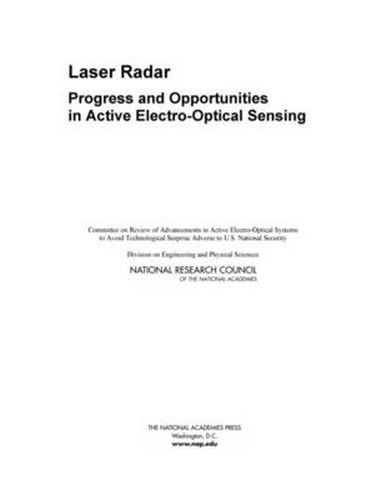Readings Newsletter
Become a Readings Member to make your shopping experience even easier.
Sign in or sign up for free!
You’re not far away from qualifying for FREE standard shipping within Australia
You’ve qualified for FREE standard shipping within Australia
The cart is loading…






In today’s world, the range of technologies with the potential to threaten the security of U.S. military forces is extremely broad. These include developments in explosive materials, sensors, control systems, robotics, satellite systems, and computing power, to name just a few. Such technologies have not only enhanced the capabilities of U.S. military forces, but also offer enhanced offensive capabilities to potential adversaries - either directly through the development of more sophisticated weapons, or more indirectly through opportunities for interrupting the function of defensive U.S. military systems. Passive and active electro-optical (EO) sensing technologies are prime examples.
Laser Radar considers the potential of active EO technologies to create surprise; i.e., systems that use a source of visible or infrared light to interrogate a target in combination with sensitive detectors and processors to analyze the returned light. The addition of an interrogating light source to the system adds rich new phenomenologies that enable new capabilities to be explored. This report evaluates the fundamental, physical limits to active EO sensor technologies with potential military utility; identifies key technologies that may help overcome the impediments within a 5-10 year timeframe; considers the pros and cons of implementing each existing or emerging technology; and evaluates the potential uses of active EO sensing technologies, including 3D mapping and multi-discriminate laser radar technologies.
$9.00 standard shipping within Australia
FREE standard shipping within Australia for orders over $100.00
Express & International shipping calculated at checkout
In today’s world, the range of technologies with the potential to threaten the security of U.S. military forces is extremely broad. These include developments in explosive materials, sensors, control systems, robotics, satellite systems, and computing power, to name just a few. Such technologies have not only enhanced the capabilities of U.S. military forces, but also offer enhanced offensive capabilities to potential adversaries - either directly through the development of more sophisticated weapons, or more indirectly through opportunities for interrupting the function of defensive U.S. military systems. Passive and active electro-optical (EO) sensing technologies are prime examples.
Laser Radar considers the potential of active EO technologies to create surprise; i.e., systems that use a source of visible or infrared light to interrogate a target in combination with sensitive detectors and processors to analyze the returned light. The addition of an interrogating light source to the system adds rich new phenomenologies that enable new capabilities to be explored. This report evaluates the fundamental, physical limits to active EO sensor technologies with potential military utility; identifies key technologies that may help overcome the impediments within a 5-10 year timeframe; considers the pros and cons of implementing each existing or emerging technology; and evaluates the potential uses of active EO sensing technologies, including 3D mapping and multi-discriminate laser radar technologies.